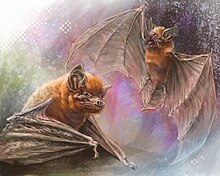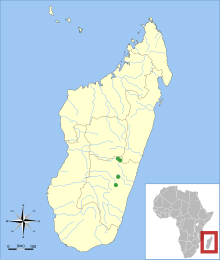Miniopterus manavi
| Miniopterus manavi | |
|---|---|
 |
|
| Scientific classification | |
| Kingdom: | Animalia |
| Phylum: | Chordata |
| Class: | Mammalia |
| Order: | Chiroptera |
| Family: | Miniopteridae |
| Genus: | Miniopterus |
| Species: | M. manavi |
| Binomial name | |
|
Miniopterus manavi Thomas, 1906 |
|
 |
|
| Collection localities of Miniopterus manavi | |
Miniopterus manavi (Manavi long-fingered bat) is a bat in the genus Miniopterus that occurs in east-central Madagascar. First described in 1906, this species was later included in the mainland African M. minor. A 1995 revision united populations of small Miniopterus from Madagascar and the Comoros as M. manavi, but molecular and morphological studies in 2008 and 2009 showed that this concept of M. manavi in fact included five different species. M. manavi itself was restricted to a few locations in the eastern Central Highlands and populations in the Comoros and northern and western Madagascar were allocated to different species.
Miniopterus manavi is a small, blackish or reddish-brown Miniopterus; its forearm length is 37.6 to 39.2 mm (1.48 to 1.54 in). The tragus (a projection in the outer ear) is narrow and ends in an angular tip. The uropatagium (tail membrane) is well-furred and the palate is flat.
Miniopterus, a widespread genus of bats in Africa, southern Eurasia, and Australia, was first recorded from Madagascar by George Edward Dobson, who mentioned the larger Miniopterus schreibersii and the smaller M. scotinus (currently M. natalensis) in his 1878 catalog of the bats in the British Museum. In 1906, Oldfield Thomas named the larger species M. majori and the smaller M. manavi. He regarded M. manavi as close to the mainland African M. minor, and in 1971, R.W. Hayman and J.E. Hill placed it as a subspecies of that species. In their 1995 Faune de Madagascar review of Malagasy bats, however, Randolph Peterson and colleagues again separated M. manavi as a species, with M. manavi griveaudi (currently Miniopterus griveaudi) from Grande Comore as a subspecies. Peterson, who died before the review was completed, had originally divided M. manavi into several species occurring in different areas, but his collaborators decided conservatively to keep M. manavi as a single species, recommending reassessment of the status of those forms as new material would become available.
...
Wikipedia

